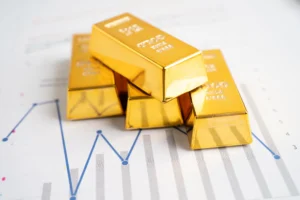The Gold Bubble 2025 has become one of the most talked-about events in global financial markets. Prices have surged in a gold price parabolic move, climbing far beyond the pace justified by macroeconomic fundamentals. For traders and investors, this level of acceleration is both thrilling and dangerous. History shows that every parabolic rally — no matter how strong — eventually corrects.
In recent months, the market has sent repeated overbought gold market signals, with the Relative Strength Index (RSI) exceeding 91, a level rarely seen in any asset class. This metric reflects extreme buying pressure and speculative behaviour rather than steady, organic growth. Meanwhile, a growing number of analysts have issued a gold market correction warning, pointing to patterns similar to past bubbles that ended in sharp retracements.
Even though gold remains a trusted safe-haven asset, its rapid rise suggests a temporary imbalance between demand and price stability. Understanding what’s driving this move—and what could end it—is essential for anyone navigating the 2025 gold market landscape.
The Gold Price Parabolic Move: Momentum Beyond Logic
A gold price parabolic move refers to a market phase where prices accelerate exponentially, forming a steep upward curve on charts. This shape shows how greed and fear often overpower logic. Parabolic moves are typically fuelled by speculation, leverage, and the belief that prices will keep rising indefinitely.
In the Gold Bubble 2025, gold’s rise began as a reaction to geopolitical tensions, slowing global growth, and increased central bank purchases. However, what started as a justified rally soon turned into a vertical climb. Prices have advanced faster than supply and demand fundamentals could justify, reflecting pure speculative energy.
For instance, gold’s move from around $2,000 to over $2,600 in less than six months resembles previous market bubbles. A similar pattern occurred in 2011 when gold reached record highs before dropping nearly 30% within a year. The structure of this rally — steep, emotional, and volume-heavy — mirrors those past cycles.
Such a gold price parabolic move often ends when momentum slows. Once traders realise the pace cannot continue, selling accelerates. If the current trend follows historical norms, gold could face a significant retracement before stabilising again.
Overbought Gold Market Signals: RSI and Market Sentiment Extremes
Technical indicators are flashing bright warning lights across multiple timeframes. The RSI crossing above 91 marks one of the strongest overbought gold market signals in recent years. Readings above 70 already indicate stretched buying conditions, but anything above 90 is a statistical anomaly.
At this stage, gold is no longer driven by fundamentals but by crowd behaviour. Sentiment analysis shows that retail traders are overwhelmingly bullish, while institutional investors are quietly reducing positions. The Commitment of Traders (COT) reports reveal that managed funds have reached near-record long positions — a pattern often seen before corrections.
This imbalance reflects excessive optimism. Similar conditions were observed in 2020, just before gold dropped from $2,070 to $1,680 in less than six months. The Gold Bubble 2025 seems to be following a comparable pattern, where excitement replaces caution.
Traders who follow market cycles know that these overbought gold market signals rarely fade quietly. They usually resolve through sharp pullbacks that reset valuations and investor sentiment. A gold price crash prediction at this stage is not speculation — it is statistical probability.
Cup and Handle Pattern: Targets Exceeded, Risks Amplified
The long-term gold chart formed a classic “cup and handle” pattern between 2020 and 2023. This bullish formation projected a price target of around $2,400 per ounce once it broke out. That level has already been exceeded. Gold’s current price action, which is trading significantly above its technical projection, suggests that speculation has replaced structured accumulation.
Exceeding the handle target does not always mean an immediate crash. However, when combined with an exhausted RSI, fading volume, and euphoric sentiment, it strengthens the gold market correction warning.
In 2011, the same pattern occurred. Gold surpassed its technical target of $1,900, reached $1,920, and then plunged nearly 25% within months. The pattern repeated in silver during 2020, where the metal’s sharp rise above its target zone led to a long consolidation phase.
The Gold Bubble 2025 shows similar excess. Technical analysts warn that once prices run too far beyond their projected targets, the probability of a reversion to the mean grows exponentially.
What Triggered Gold’s Rise — And Why Those Triggers Are Fading
The rally leading up to the Gold Bubble 2025 had solid initial reasoning. Several global factors contributed to rising gold prices, including inflation fears, geopolitical uncertainty, and central bank diversification.
Between 2022 and 2024, major central banks like China, India, and Turkey significantly increased gold reserves, aiming to reduce dependence on the U.S. dollar. At the same time, inflationary pressures drove investors toward tangible assets. Falling real interest rates further fuelled the gold price parabolic move, as low-yielding bonds made gold look more attractive.
However, those supportive forces are now fading. Inflation is slowing in key economies, the Federal Reserve has shifted to a neutral policy tone, and the U.S. dollar index has stabilised near multi-year highs. Additionally, China’s economic data shows signs of recovery, reducing the need for aggressive safe-haven buying.
This shift leaves the Gold Bubble 2025 vulnerable. Without new catalysts, momentum tends to fade quickly. Once investors recognise that the core triggers are weakening, profit-taking accelerates. That is why several analysts believe a gold price crash prediction could soon materialise.
Price Levels Suggesting a 20–30% Pullback
Technical retracements are one of the most reliable tools for identifying potential correction zones in any overheated market. In the context of the Gold Bubble 2025, these retracements offer a roadmap to anticipate where the current gold price parabolic move could find support after momentum fades. Historically, when gold experiences rapid vertical climbs, it rarely sustains them without a measurable correction. Data from previous cycles—notably in 2011 and 2020—reveal that retracements of around 20–30% are not only common but also healthy for long-term stability.
Analysts are focusing on three crucial levels that could define the shape of the next correction phase:
- $2,200 per ounce: The first key line of defence, aligning with the 23.6% Fibonacci retracement from recent highs. This level often attracts initial buyers seeking to catch a short-term dip.
- $2,000 per ounce: A powerful psychological threshold that previously acted as resistance before the breakout. A revisit here would likely test trader conviction and long-term sentiment.
- $1,850 per ounce: The deeper correction zone is tied to the 38.2% Fibonacci level, where longer-term investors could step back in.
If gold decisively breaks below $2,200, momentum traders are likely to exit aggressively, accelerating declines. Similar moves were recorded in the 2011 post-rally period, when profit-taking cascaded into a rapid 25% drop within weeks. Yet, such pullbacks are not bearish long-term — they serve to clear speculative excess and realign pricing with fundamentals. Traders who anticipate these gold market correction warning zones can reduce exposure early, secure profits, and prepare for fresh opportunities once the market stabilises.
Why Parabolic Moves Are Always Correct
Every parabolic rally in market history has ended with exhaustion, and gold is no exception. A gold price parabolic move is driven by emotional buying, herd psychology, and leverage rather than steady demand. As prices climb rapidly, enthusiasm attracts more participants until buyers run out. At that stage, even small shifts in sentiment can trigger major sell-offs.
The Gold Bubble 2025 resembles the same curve observed during the 1979–1980 gold boom, where prices doubled in a few months before collapsing by nearly half. It also echoes the 2011 rally, which ended with a swift 28% drop once momentum faded. These historical precedents show that parabolic shapes have a predictable life cycle — a sharp rise, an emotional climax, and then an equally steep decline.
In the current cycle, large institutional traders appear to be scaling back positions gradually, signalling caution beneath the surface. Once short-term support breaks, algorithmic systems and leveraged positions often intensify the move downward, creating what analysts call a “cascade effect”. Such liquidations can exaggerate corrections, even when fundamentals remain intact.
Eventually, the speed of the fall balances the excess of the rise. The Gold Bubble 2025 perfectly fits the anatomy of a mature speculative rally — steep ascent, euphoric sentiment, and mathematical inevitability of reversion. When markets rise too fast, gravity — both financial and psychological — always pulls them back to equilibrium.
Why a Core Gold Position Still Matters
Despite the looming correction, gold’s core value remains beyond dispute. Even when prices retreat, the metal continues to serve as a hedge against currency depreciation, inflation shocks, and geopolitical uncertainty. A gold market correction warning does not mean long-term weakness; rather, it signals an opportunity to reset and rebuild from a healthier base.
Position management becomes essential during such phases. Reducing exposure in overheated zones and gradually reallocating after retracement allows traders to protect profits while staying aligned with the broader uptrend. This method has worked through past market cycles. After the 2011–2013 decline, gold eventually found support near $1,200 before recovering above $1,900 in 2020. Similarly, after the 2020 correction, renewed inflationary pressures revived investor demand.
These historical cycles prove that gold does not lose relevance — it merely breathes between expansions. Maintaining a core gold position ensures participation in future rallies while cushioning against emotional decisions during volatile periods. For both institutional and individual portfolios, disciplined rebalancing between profit-taking and reinvestment keeps capital productive and protected. Long-term investors recognise that short-term pullbacks are moments of recalibration, not signals to abandon a proven hedge.
Strategy: Reduce Now, Reload Cheaper
Capital preservation defines the smartest approach in the Gold Bubble 2025 environment. Chasing euphoric rallies exposes traders to unnecessary risk, while a strategic “reduce and reload” plan preserves gains and positions portfolios for the next phase of opportunity. The key lies in disciplined execution — adjusting exposure gradually rather than reacting emotionally to price spikes.
Practical steps include:
- Trim positions incrementally as overbought indicators persist, reducing exposure before volatility intensifies.
- Apply trailing stops to lock in profits while allowing limited room for upside continuation.
- Track resistance zones carefully to avoid new entries near exhaustion points.
- Plan re-entries near key supports such as $2,000 or $1,850 to capture value after a retracement.
- Monitor global data, especially inflation trends and dollar strength, as they influence recovery timing.
This structured approach enables flexibility and confidence during uncertain phases. Reducing exposure when markets overheat prevents emotional errors. Re-entering at lower levels improves return potential once the next accumulation phase begins. Traders adopting this strategy protect their capital and remain ready when the gold price parabolic mover resets to sustainable growth.
In the end, the most successful market participants are those who anticipate cycles rather than chase them. Reducing risk during speculative highs and reloading during value lows transforms volatility into opportunity — a principle that defines smart participation in every gold cycle.
Important Takeaway: Risk Control Defines Success in 2025
The Gold Bubble 2025 demonstrates that even the most stable assets can become speculative when sentiment runs high. Technical, fundamental, and behavioural indicators all point toward a looming gold market correction warning.
However, corrections are not disasters; they are natural components of healthy markets. The coming pullback may reset valuations and offer fresh opportunities for disciplined traders. Recognising overbought gold market signals, understanding gold price parabolic move patterns, and respecting technical levels can make the difference between preserving profits and suffering avoidable losses.
The path forward favours awareness and adaptability. Protect profits, manage exposure, and be prepared to capitalise when the gold price crash prediction plays out and stability returns.
Read here to learn more about “Decentralized Finance (DeFi) in 2025 for Smarter Wealth Building“

I’m Chaitali Sethi — a seasoned financial writer and strategist specializing in Forex trading, market behavior, and trader psychology. With a deep understanding of global markets and economic trends, I simplify complex financial concepts into clear, actionable insights that empower traders at every level. Whether it’s dissecting winning strategies, breaking down market sentiment, or helping traders build the right mindset, my content bridges the gap between information and implementation.

